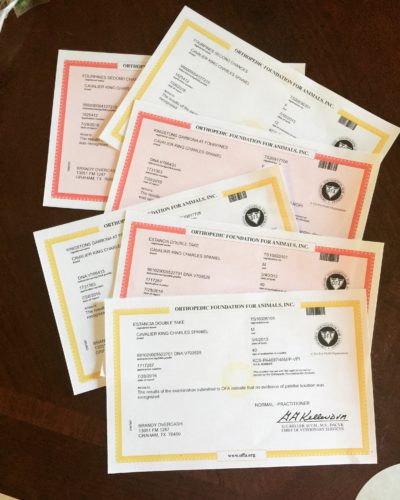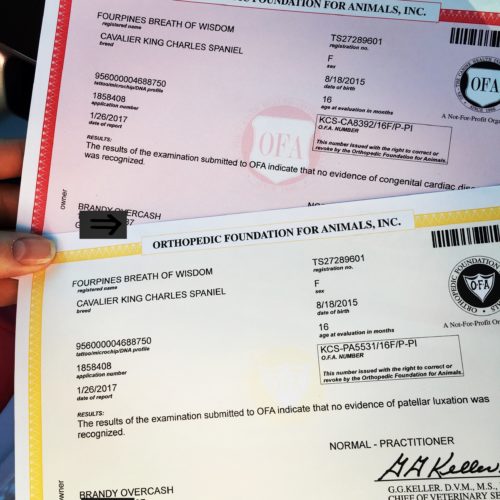|
Allergies: In Cavalier King Charles Spaniels or any dogs, allergies often show up as skin conditions, itchy ears, head-shaking, scratching, or bald or raw spots, though they can also cause runny eyes and nose, sneezing, coughing, vomiting, and diarrhea. Dogs can be allergic to many of the same things people can: dust, pollen, grasses, mold, flea bites, and many foods. The biggest causes of allergies in my opinion is in the type of dog food you are feeding and/or the products you are using to groom your dog with. Dog food really isn’t one bag fits all you must consider your lifestyle, weather conditions, etc. Possibly even consider a RAW diet. The other area is grooming and most shampoo’s readily available on the shelves at pet stores are too high in PH and just add another level of problems along with the dog food. My advise is always to simplify. The fewer ingredients in a product, the less likely it is for your pet to have an allergy to a particular “trigger” in that product.
Anal Sac Conditions: Anal sacs are tiny organs, on either side of the lower half of a dogs anus, which produce a liquid thought to help a dog mark their territory. The ducts that lead from the sacs to the anus can become blocked or infected. If your Cavalier King Charles Spaniel starts scooting his bottom along the ground and licking his anus, this may be the reason. Your vet can clear the ducts or show you how to squeeze the glands yourself. If your dog is scooting its bottom on the floor most likely they are needing their anal sacs expelled. Sometimes they are able to do this themselves, but if scooting continues after a day or two you should either check the glands yourself or take your dog to a vet to be examined. If you take your Cavalier King Charles Spaniel to a groomer once a month then your groomer will take care of this for you.
Correct Bite: Cavalier King Charles Spaniel Puppies have 28 primary (baby) teeth that begin to erupt around 4 weeks of age. Between 4 and 5 months of age a Cavalier King Charles Spaniel puppy will get his permanent teeth pushing out the baby teeth. If baby teeth have trouble falling out you will need to see your veterinarian as retention can lead to misalignment. A Cavalier King Charles Spaniel’s bite can take up to two years to settle into permanent position. A scissor bite at 8 weeks will usually remain a scissor bite in adulthood. An undershot bite will often correct itself, but an overshot bite will never correct itself. A scissor bite is most preferred, but a level bite in Cavalier King Charles Spaniel’s is acceptable in the conformation show ring when being judged. An under bite occurs when the lower teeth protrude in front of the upper jaw teeth. An over bite (parrot mouth) occurs when the lower jaw is shorter than the upper. I have witnessed a puppy having a scissor bite at 8 weeks and then around 6 months of age and slight under bite develops, but then around 12 months of age the bite returns to a scissor bite. As puppies develop they go through structural changes that can throw the bite off temporarily.
|
|
|
|
|
|
Scissor Bite
|
Level Bite
|
Under Bite
|
Over Bite
|
Colitis in Puppies: is an inflammation of the colon or lower bowel, and has many different causes, from bacterial infections to allergies. Since causes vary so do symptoms and treatments. Generally, you might see feces with mucus or blood in it, bloody diarrhea, or unproductive straining after passing feces. Severe dehydration can kill a puppy quickly so immediate veterinary care is crucial. Colitis can be found in adults as well. Usually if an adult has experienced a stressful situation then the Colitis can appear.
Diabetes: When the body stops making insulin or stops responding to it, it can no longer process sugars in the blood efficiently. The kidneys will release sugar into the dogs urine, which makes her urinate more and have to drink more. The primary symptoms of diabetes are excessive drinking and urination, sometimes accompanied by weight loss despite increased appetite, or blindness or numb limbs. Treatment is available, and early detection is crucial.
Epilepsy: Cavalier King Charles Spaniels and any dogs can have seizures just like people, and the causes can be varied. There are several stages of a seizure, which in dogs are generally expressed (to varying degrees) in these ways: changes in mood or behavior, sometimes for several days before a seizure; the “aura,” which signals the start of the seizure, can include nervousness, whining, trembling, salivation, excessive affection, wandering, restlessness, hiding, and general apprehension; the seizure itself, lasting a few seconds to a few minutes, in which the dog may fall to the ground, lose consciousness, gnash teeth, thrash his limbs, bark, paddle his feet, and lose control of his bladder and bowels; and the “ana-lean” stage, after the seizure, in which the dog may pace, become temporarily blind or deaf, and eat or drink excessively. If you suspect your dog may have had or be having a seizure, consult your vet.
Episodic Falling Syndrome: This condition appears after exercising when the Cavalier King Charles Spaniel suddenly collapses. The condition appears to be life-long, but not life-threatening. There is now a DNA test through the Animal Health Trust in the United Kingdom. Through DNA testing we can control this genetic disorder now and avoid producing affected offspring.
Fleas and Ticks: Fleas can bother your dog dreadfully, so adequate flea prevention is essential, especially in the warmer months. Ticks can pass on diseases such as Lyme disease, so if you live in an area with ticks (most of the country now), do frequent tick checks all over your Cavalier King Charles Spaniel’s body–especially for Cavalier puppies, whose immune systems are not yet developed. Again we feel less is more. We make our own flea/tick spray with distilled water, witch hazel and essential oils. Do your research and check with your vet or holistic vet before using EO’s on your dog, as they are quite strong and you must use caution.
Hip Dysplasia: Cavalier King Charles Spaniel can sometimes develop hip dysplasia, but the breed risk ranks 81st according to the Orthopedic Foundation for Animals (OFA) data. To get a true diagnosis of this disorder a Cavalier King Charles Spaniel must be put under anesthesia by a veterinarian with experience in x-raying the hips. There are two organizations that can be used to get a diagnosis: OFA and the Pennsylvania Hip Improvement Program (PennHip). This disorder can also be caused from trauma after a Cavalier King Charles Spaniel puppy is born so not all cases of hip dysplasia are genetic. Most Cavalier King Charles Spaniels with hip dysplasia live a long and normal life without clinical signs or much discomfort since they are a toy breed.
Hypoglycemia: (low blood sugar) is common in Cavalier King Charles Spaniel puppies and they usually outgrow the condition by 6 months of age unless there is a problem causing the condition. Cavalier King Charles Spaniel puppies should be fed 3 to 4 times per day and especially Cavalier King Charles Spaniel puppies with this condition. If a Cavalier King Charles Spaniel puppy is traveling and needs to be without food for an extended period of time then the Cavalier King Charles Spaniel puppy needs to be supplemented with Nutrical or Nutristat to maintain blood sugar levels during travel. Symptoms include but are not limited to: Slow heartbeat and breathing, weak, sleepy, disoriented, wobbly, glassy eyed, and seizures.
Inguinal, Umbilical, and Scrotal Hernias:
Inguinal Hernia: The condition is the result of abdominal organs, fat or tissue protruding through the inguinal ring. Inguinal hernias are presented as skin-covered bulges in the groin. They can be bilateral, involving both sides, or unilateral, involving only one side. Inguinal hernias are more common in females than males, but do occur in both sexes. As with umbilical hernias most inguinal hernias will shrink and disappear as the puppy grows, although you must keep an eye on the size of the hernia(s). Inguinal hernias can also occur in un-spayed, middle-aged female dogs. This may occur as the result of stretching of abdominal tissue due to pregnancy, or atrophy of abdominal tissue and musculature due to advanced age.
Umbilical Hernia: This type of hernia is also very common in Cavalier King Charles Spaniel puppies and seldom need to be repaired. It is most likely caused when the mother Cavalier King Charles Spaniel pulls too hard on the umbilical cord at birth causing the hernia. There are different opinions on this type of hernia about whether it is genetic or caused at birth. If the umbilical ring does not close immediately after birth sometimes a little fatty tissue is trapped on the outside of the abdomen after the ring closes causing a bubble-like area where the umbilical cord was attached. If the bubble cannot be pushed back up into the abdomen it is called a non-reducible hernia. If the bubble can be pushed back up into the abdomen then it is called a reducible hernia and surgery is advisable if the Cavalier King Charles Spaniel is going to be bred. This umbilical hernia existing on a future show dog is still allowed to show in AKC sanctioned events and a dog with this type of hernia can still be bred. Since this type of hernia is very widespread in Cavalier King Charles Spaniels and does not harm the Cavalier King Charles Spaniel puppy as far as future health is concerned the condition does not lower the adoption price of a Cavalier King Charles Spaniel puppy with this condition.
Scrotal Hernia: (Affects only male Cavalier King Charles Spaniels) The tube that descends into the scrotum is too large, which allows intestines to descend into the scrotal canal. This type of hernia will also need to be watched carefully and if it does not repair on its own it will need to be fixed during the neutering process.
Luxating Patellars: Is a dislocated kneecap that cannot stay in its groove. Normally the kneecap moves up and down in a groove along the femur, but if this groove is shallow, the kneecap may move laterally and slip out. Most of the time a Cavalier King Charles Spaniel with a luxating patella has a medial luxation which can be caused by a traumatic accident or it can be genetic in origin. This disorder can also occur from trauma and the only repair for the disorder is surgical. Signs of luxating patella include: difficulting straightening the knee, pain in the stifle, and limping.
Mitral Valve Disease (MVD): MVD is a degeneration of the heart’s mitral valve, one of four sets of valves in a Cavalier King Charles Spaniel’s heart. As the mitral valve degenerates, the valve no longer fully closes after each pumping action, allowing some blood to flow backwards through them from the ventricle back into the atrium. As the condition worsens, more and more blood is able to backflow through the valve. In the final stages, the valve’s struts sometimes break, causing the valve to collapse completely. MVD is the most common heart disorder in older dogs of all breeds, affecting more than a third of all dogs over 10 years of age.
Obesity: Obesity is just as dangerous for dogs as it is for humans. Fat Cavalier King Charles Spaniels are a higher risk in surgery, more prone to injury, as well as to metabolic disorders such as diabetes, and have more stress on their heart, lungs, liver, kidneys, stomach, intestines, and joints. If you suspect your dog to be over weight, please consult your vet about a reasonable diet for your Cavalier King Charles Spaniel.
Open Fontanel: Congenital Open Fontanel is seen in several toy dog breeds, but most often it’s seen in Chihuahuas. Occasionally is will appear in a Cavalier King Charles Spaniel. The fontanel is the area at the top of the skull where the bone plates merge. When babies (human and dog) are born the bony plates of the skull are usually partly soft and separated. Usually this area closes to about the size of a dime by the time the puppy is about one year old, but sometimes the bony plates never completely fuse, leaving a hole in the top of the skull that has a soft mushy feel when you touch it. The affected pup can still live a long, full and active life. There is no treatment for an open fontanel. Since open fontanels are either hereditary or genetic, once a good breeder determines which parent dog carries the gene the parent dog should be retired from the breeding program and spayed or neutered. Dogs with open fontanels should not be bred. We have never personally seen this in Cavalier King Charles Spaniels.
Parasites: Most canine parasites are worms (hookworms, round worms, tapeworms, heartworms), and can be taken care of by your vet. General symptoms include lethargy, diarrhea, and small worms or egg fragments in the feces, though specific parasites have different symptoms. Mites, fleas and ticks count among external parasites. Even indoor dogs can catch parasites via mosquitoes, or brief periods they spend outdoors or with other dogs.
Snorting: Some Cavalier King Charles Spaniels will snort, especially when excited. This is a common condition in all short-nosed breeds. It may seem like an asthmatic episode, but the condition is not dangerous. Simply place your hand over your Cavalier King Charles Spaniel’s nostrils and muzzle for a few seconds and restrict the intake of air and the snorting should stop. It can sometimes take a couple of tries, but if the symptoms occur along with lack of appetite or a persistent cough seek a veterinarian’s assistance.
Syringomyelia (SM): is a condition in which fluid-filled cavities develop within the spinal cord near the brain. It is also known as “neck scratcher’s disease”, because one of its common signs is scratching in the air near the neck. The back half of the Cavalier King Charles Spaniel’s skull typically may be too small to accommodate all of the brain’s cerebellum, and so it squeezes through the foramen magnum – the hole at the back of the skull – partially blocking the flow of cerebrospinal fluid (CSF) down the spinal cord. The variable pressure created by the abnormal flow of CSF is believed to create the SM cavities – called syrinx – in the spinal cord.
Swimmer Puppy Syndrome: is when a young puppy develops a flat chest and sternum, which makes them unable to get their legs under them. If you were to look at them from above, they resemble a turtle. The puppy is unable to crawl or walk. Normally their chest is an oval shape, but when a puppy begins to develop Swimmer Puppy Syndrome as its crawling around in those first few weeks its bones – which aren’t yet dense but rubbery – begin to take on a flattened shape and the chest begins to splay out horizontally as opposed to lengthening. I have never experienced a swimmer puppy. I do know however, that they can go on to live a normal life. My veteran breeder/friends insist it is well worth the effort to rehabilitate them.
Undescended Testicles: Sometimes male Cavalier King Charles Spaniel puppies are slow to have one or both testicles descend into the scrotum. It now becomes a waiting game until 6 months of age. If at 6 months of age the testicles are not in place then the Cavalier King Charles Spaniel puppy needs to be neutered. When feeling for testicles in small Cavalier King Charles Spaniel puppies one must keep in mind that the slightest pinch can cause the Cavalier King Charles Spaniel puppy to automatically retract a testicle, so I always play it safe and never feel for testicles. I prefer to just wait and watch and usually around 8-10 weeks I can use one finger to gently touch and locate both testicles.
With heart disease being, arguably, the biggest concern amongst Cavalier King Charles Spaniels owners, this link address many of the questions you may have. It also includes what a heart murmur is, types of heart murmurs, and the possibility of your puppy (of any breed) having an innocent, temporary “flow murmur”
http://www.theveterinaryexpert.com/heart-disease/heart-murmurs-in-dogs/
|












